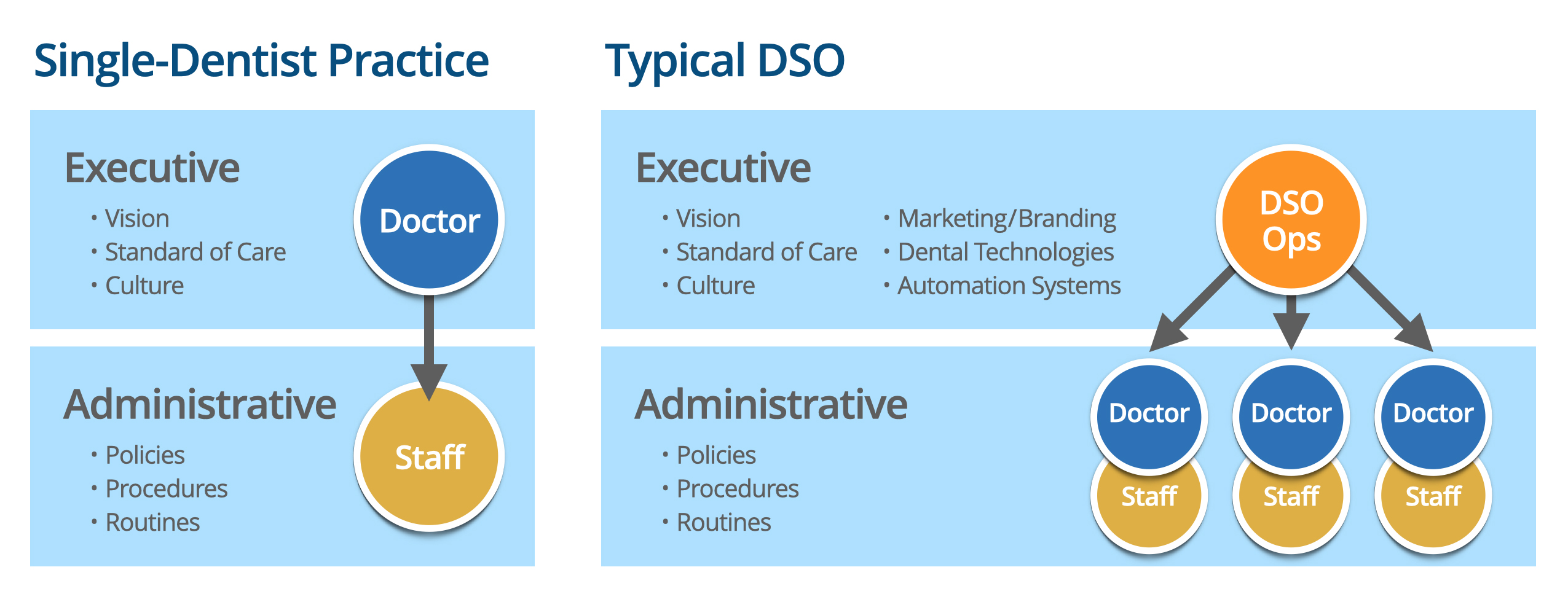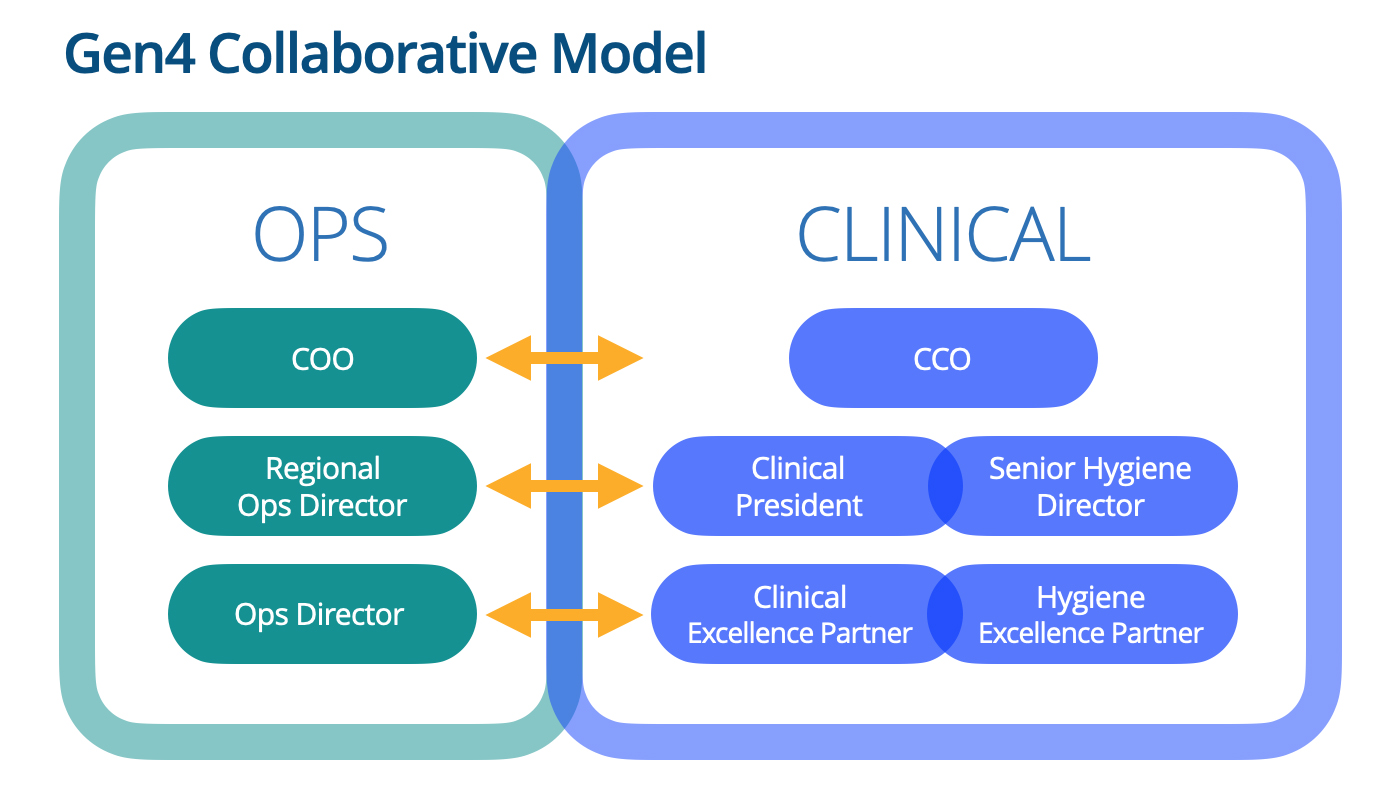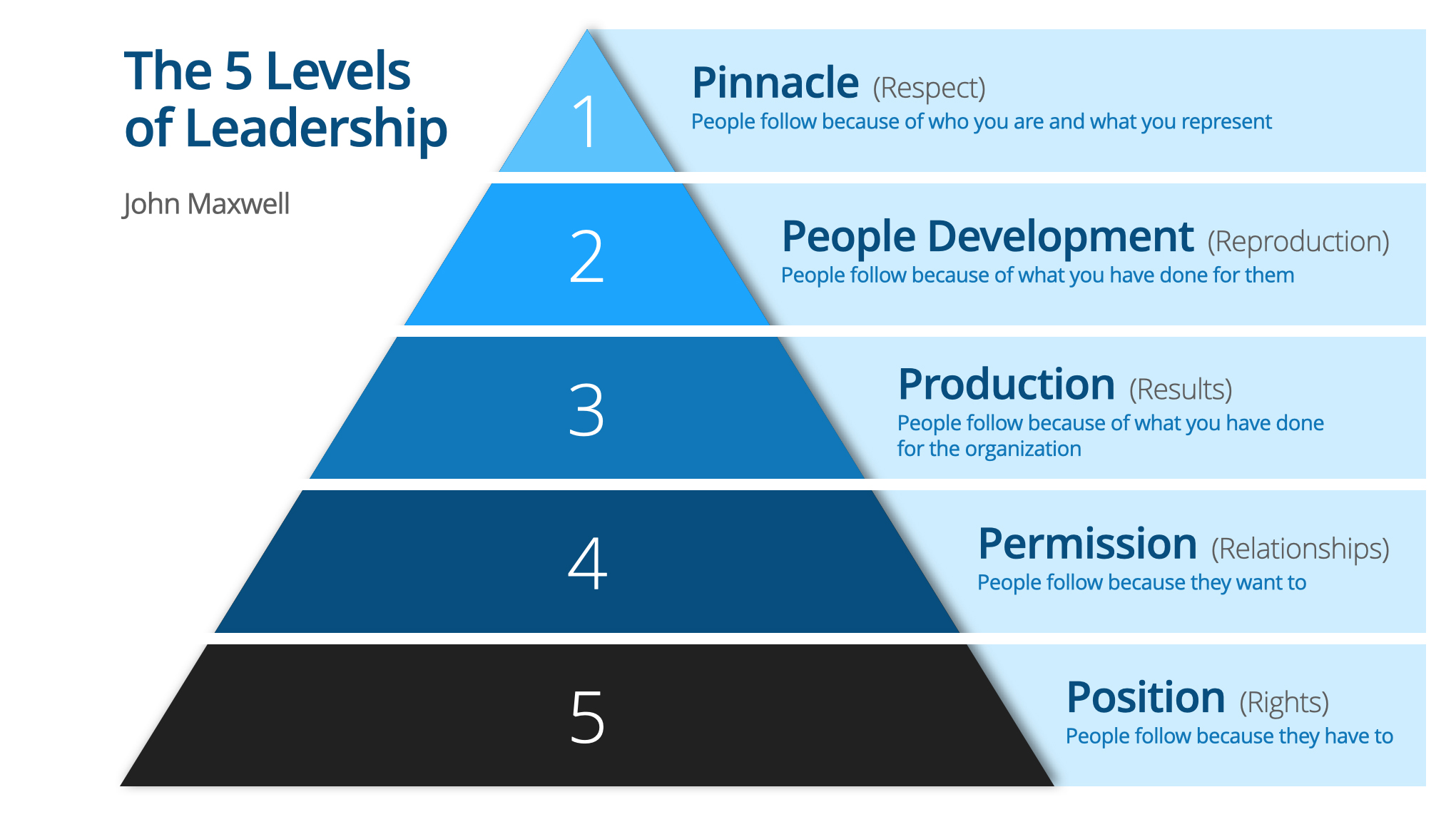Doctor Collaborative Model
“We are here to change dentistry”
Mitch Ellingson on the Collaborative Doctors model, the Autonomy paradigm - and the Big Hairy Audacious Goal
Remember why you started your dental practice? You loved to help people smile, right? But now it seems like you spend all your time figuring out employee benefits and the clinic’s wifi router and Facebook ads and a hundred other things that have little to do with dental excellence.
So you start to consider merging your practice with a Dental Service Organization. Maybe the DSO will free you from administrative tasks so you can get back to your first love – helping people smile.
But there’s an elephant in the room: In a typical DSO, you fear you’ll lose control. Accustomed to directing your staff as you feel best, you worry the staff will be directing you instead – clock your minutes per patient, say, or shave your cost of materials. So how do you balance the tension between clinical excellence and operational efficiency? Who’s in charge – you, or them?
Gen4 Dental Partners say that’s a false premise. They believe in a different paradigm: the Collaborative Doctors model. Dr. Mitch Ellingson, Gen4 Chief Clinical Officer, explains.
“I'm a ‘call-out-the-elephant-in-the-room type guy,” Mitch said. “And the elephant in the room is that doctors are worried Operations are going to lead them and operation teams are worried doctors are going to push back. That's been the world for the last quarter century, right?
“But the main reason doctors come to Gen4 is because they realize they're still going to have a voice. Our direction is still going to be aligned with where they would want to go. As they collaborate, it's going to feel natural to them. And then the operations team is going to deliver results that are aligned with what the doctors collectively think are best for each practice, best for the group, and best for Gen4 overall.”


A team of doctors and Operations
The Collaborative Doctors model challenges both sides.
“To the dentist, the organization is saying, ‘Hey, doctor, I need you to be more operationally focused and learn from the operations team what that actually means. Be humble, park the ego and learn from them.’
“And to Operations, the dentist is saying ‘You’ve been doing this for 10 or 20 years, so I need you to use that knowledge not to just do what you've always done – I want you to come in and learn what clinical excellence really is. Like, really dig into clinical excellence, pretend you've never been in dentistry before and learn it from the ground up again so that you can embody what it means to be clinically excellent.”
Where those two meet “is a clinical operations team that is truly a team. It's not doctors or Operations. It's a team of doctors and Operations,” says Mitch, DDS, who has seen both sides of the coin as a practicing dentist for 13 years and EVP of Spear Practice Solutions for five.
Autonomy, redefined
When a practice owner joins Gen4, the promise is that they will keep their clinical autonomy. That’s critical because Gen4 only partners with practice owners who have what Mitch calls “the leadership backbone.” Each is a leader in their field, a premier clinician accustomed to wielding absolute authority over how to best treat each patient. But that doesn’t mean – can’t mean – each doctor can wield absolute authority over how to run their shop, because with XX (and growing) doctors, that means shops would run XX different ways, which would lead to chaos.
“So let me define what autonomy means in Gen4,” Mitch says. “Typically, you're worried someone's going to start telling you what you can and can’t do. But when we talk about autonomy, actually, it's the opposite of that – the reality is we're going to ask you to lead more. We’re going to amplify your voice. Your ideas are going to influence everyone. And theirs are going to influence you. That’s the exact opposite of going it alone.”
And that leads to challenging – and exciting – growth. You get to learn how to lead a different way. The Gen4 way.
“For a lot of docs, they've been on their own for such a long time that they almost forgot how exciting it is to be with peers who are challenging each other to think bigger, to take the next step, to evolve the idea.”
‘That’s where the goose bumps come from’
Recently, Gen4 held a series of three workshops in which their senior clinicians did just that. They brainstormed ideas to take all of their practices collectively to the next level. And as they collaborated, he says, “they naturally elevated the ideas together. And when you elevate an idea together, that’s where the goose bumps come from, right? That's where you go, ‘wow, okay!’ They're like, ‘I've never thought about it like that.’ Now you got me, right?” Mitch grinned.
The benefits go far beyond shaving minutes or counting dimes. As Gen4’s clinicians challenge each other, their leadership skills grow – and that reaps benefits to them as human beings. “I do believe a lot of the things you learn as a better leader translate to your life. They translate to your family. They translate to your relationships,” he says, his voice rising with passion.
“Maybe you used to be married to your opinion – you were always right. And now you're amongst a group who make you realize, hey, how many times maybe you weren't right? And you start to go, ‘Wow, man, I've been thinking about this backwards.’ “
As new ideas – indeed, new ways of thinking – take hold, there’s a trickle-down effect. Team members benefit. Patients benefit. And the dentist benefits because their ideas, refined by fire, are amplified on a much bigger platform impacting many more teams and patients.
‘It’s way harder than anybody anticipates’
Mitch speaks from personal experience. After earning a B.S. and D.D.S. from the University of Minnesota, Mitch performed dentistry for 13 years while owning and operating multiple practices in Phoenix, AZ. Then he founded and led Spear Practice Solutions, the division of Spear Dental Education that consults with a wide variety of dentists. That’s where he learned how hard – and how valuable – collaboration really is.
“I've personally experienced it. I've been through the transition of going from private-practice dentist to working inside a group, and it is really hard. It's way harder than anybody anticipates. And so I respect that as doctors go through this, I have a lot of patience because it was one of the hardest things I've ever done, and I know they're feeling that. Going through that transition from being king of your own island to being a leader in a group is really hard.
“But it's also really powerful once you get there,” he says.
Maxwell’s Five Levels
So how does one go about the transition from king to leader? What’s the journey look like? The roadmap is John Maxwell’s book, The Five Levels of Leadership.
Mitch says all Gen4 dentists are trained in Maxwell’s Five Levels of Leadership.
- Position. People follow you because they have to.
- Permission. People follow you because they want to.
- Production. People follow you because you get things done.
- People Development. People follow you because you empower them to lead in their own right.
- Pinnacle. People follow you because of who you are and what you represent.

Mitch says all Gen4 dentists are trained in the concepts behind each level. Then they apply it to their team. Mitch asks each to write down the names of their most trusted team members, then assign a level to each. Typically, they assign fours and fives to their best people.
Then he asks them to write down the names of Gen4 executive management – CEO Lamonte Jensen, CFO Rob Mullins, VP of Operations Tammy Barker, CMO Amy McNeil and himself. Again, he asks them to assign a level to each.
‘They’re all like, ‘Uh, zero. I don’t even know these people.’ And I say, ’That’s my point. Now reflect for a moment on what it took for your people to get to fours and fives. Did you have good days and bad days? Did you have moments when you were an idiot and moments when you were a hero? Absolutely.
“ ‘Remember that journey, because you just started the journey again, just with different people. We have to work our way up to fours and fives again.’ “
“So now they have a roadmap to leadership, a measuring stick to mark their progress, a group that challenges them to lead, and a platform of people to do it with, and for.”
Not everyone is willing or able to accept the challenge, he admits.
“That's why the selection process is so important. We tell them we're not a DSO. We're not playing by their rules. We are here to change dentistry. And if you don't embody that and believe that inside of your soul, you should not join Gen4. Because we aren't saying it just to attract people. We're saying it because that's who we are.” He nods. It’s the difference between a slogan and a noble cause.
The ADA and the BHAG
It gets even better. A year ago, Mitch recalls, he was talking with one of Gen4’s founding dentists about the future of dentistry – about the future of the American Dental Association. As DSOs consolidate more and more single-practice dentists, for the ADA to remain relevant in the fast-changing field of dentistry, they agreed, the ADA needs to learn the Collaborative Doctors model.
“And I’m like, ‘Let’s go do this! Let’s really change things’” at the ADA. So they did. After a year of meetings with “probably more than a hundred conversations,” he says, “suddenly the light came on. They said ‘We agree. You guys need to help us be the voice of the American dentist.’”
The result? Next month, Gen4 will hold 4Front, its annual conference at which its dentists and dental professionals will gather from all over the nation to chart their future collectively. And for the first time ever, the president of the ADA will speak. Their Big Hairy Audacious Goal: Evangelize the ADA, and through it all dentists, to embody the Gen4 noble cause.
Why? “Because we are all lovers of our profession. Dentistry is the last great profession that is run by the people who do it – the dentists.” Gen4 is amassing a group of Level 4 leaders who seek to empower all dentists to do dentistry on their terms – not let it be dictated by administrators (as has happened in medicine, say, or pharmacy.) “Our people have a real passion for our profession; they want to protect it and elevate it.”
With the ADA in attendance, Mitch predicts, 4Front will galvanize a change in direction for dentistry. “We're basically calling every DSO to the mat. We’re saying, ‘If you want to compete in the consolidation space, you're going to need to get your dentist involved with organized dentistry again. Because otherwise every dentist who is really into dentistry will never go your way again. They're going to want to come our way.”
He smiles. “At Gen4, we believe the measure of our success is when people copy what we do.”
SIDEBAR: What Is a Big Hairy Audacious Goal (BHAG)?
A big hairy audacious goal, or BHAG, is a clear and compelling target for an organization to strive for. The term was coined in the book Built to Last: Successful Habits of Visionary Companies by Jim Collins and Jerry Porras in 2005.
BHAGs are meant to inspire and energize people to implement a big-picture plan that could take a decade to complete.
The classic example is the moonshot: President John F. Kennedy announced in 1961 that the United States would land a man on the moon by the end of the decade. It was an inspiring vision with a clear target and a steep (some said impossible) challenge. And it was achieved in 1969.
What makes a BHAG (pronounced “bee hag”) useful? It's a long-term goal that everyone in a company can understand and rally behind. Simply put, a well-thought-out BHAG shifts the focus to the bigger picture. It excites and energizes people in a way that quarterly targets and bland mission statements often fail to, and when successful, can prove to be the cornerstone for tremendous achievement.
Here’s one modern example of a BHAG: SpaceX intends to settle Mars. Here’s another: Gen4 Dental Partners intends to transform dentistry.